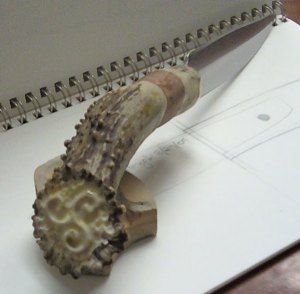Hazuya and jizuya finger stones are not as insurmountable as I thought. I am not going to call myself a master of the craft, but I do know that I am learning things. That is one of the best things about hobbies that involve crafting or fine art: you get to observe your progress over time.
Last week, I was working with finger stones and all I was getting out of them were lovely fine scratch patterns on the surface of the blade that I was using as practice. This week, I can start to see how those micro-scratches move toward the indescribable finish on a properly polished Japanese sword. While the polishing that I’m doing is far from perfect, it is vastly better than what I was doing before.
What I learned looks like this:
1. When books and websites discuss this sort of polishing, they tell you that the stones must be ground down to (what seems like) paper-thin chips. It makes a difference. Why? I don’t know. All I know is that when I tried it, the finish started to improve.
2. You can’t just use water as a lubricant in this stage of the process. According to “The Art of Japanese Sword Polishing” (ISBN:978-4-7700-2494-7) you have to use “tojiro paste”. That is like the slurry that nagura stones build up on other stones, but using only the highest quality natural stones that you have. Uchigumori grade, at the very least.
Don’t try to flout 800 years of tradition. This step is absolutely necessary as well.
3. This sort of polishing will take longer than you really wish it would. You may end up needing 3 or more jizuya stones of different hardnesses. You’ll probably want to collect as many specimens of Narutaki (raw material for jizuya) as you can. Every stone and every flake are different.
4. No, this will take a long time. It will tire out your hand and shoulder.
5. Go out and buy that book. It is a good overview, even if it isn’t quite the in-depth examination of the craft as one might like.
6. Get good stones. Use clean water.
7. You have to practice a lot. Don’t be afraid of taking your metal back down to a koma-nagura polish and start over.
The other thing that exploring this is teaching me is this: traditional polishing of this kind is a true art and it adds (and SHOULD) a lot to the price of modern swords.


